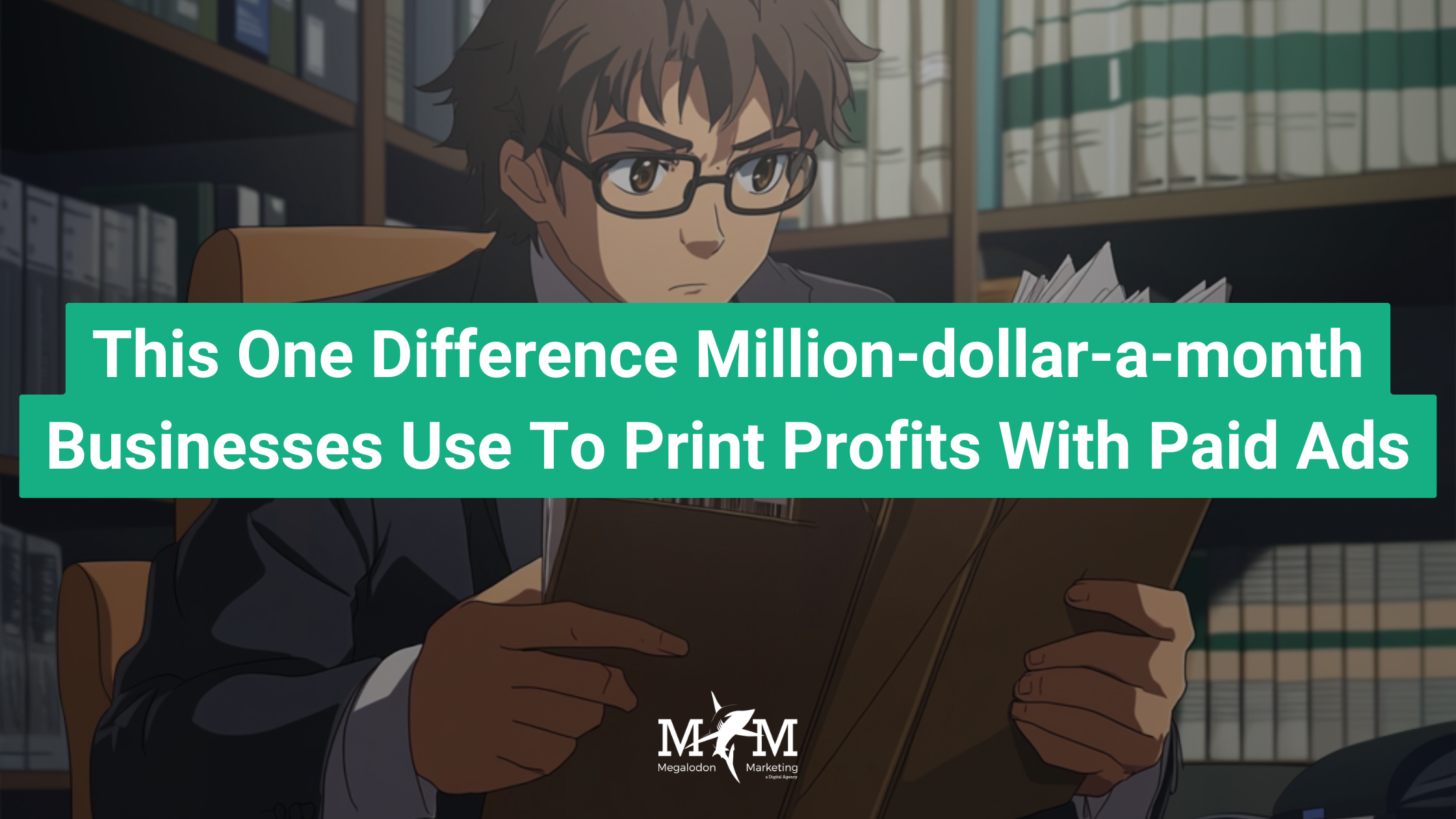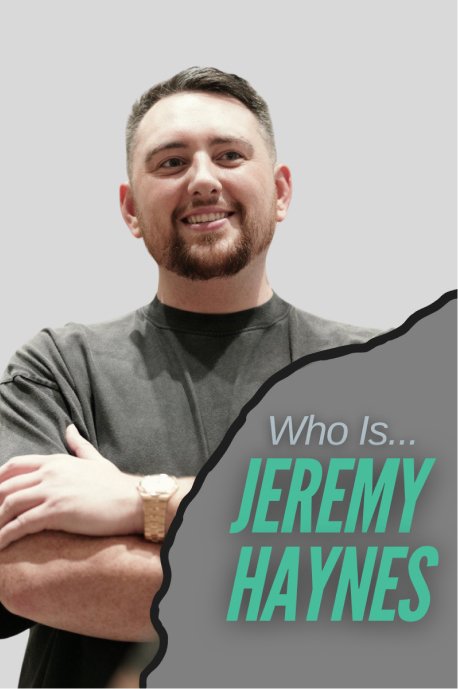I hope you enjoy reading this blog post. If you want my team to just do your marketing for you, click here.

I hope you enjoy reading this blog post. If you want my team to just do your marketing for you, click here.
Author: Jeremy Haynes | founder of Megalodon Marketing.

Earnings Disclaimer: You have a .1% probability of hitting million dollar months according to the US Bureau of Labor Statistics. As stated by law, we can not and do not make any guarantees about your own ability to get results or earn any money with our ideas, information, programs or strategies. We don’t know you and, besides, your results in life are up to you. We’re here to help by giving you our greatest strategies to move you forward, faster. However, nothing on this page or any of our websites or emails is a promise or guarantee of future earnings. Any financial numbers referenced here, or on any of our sites or emails, are simply estimates or projections or past results, and should not be considered exact, actual or as a promise of potential earnings – all numbers are illustrative only.
You want to know exactly why your ads stop working the moment you try scaling them from “pretty good” to “I want to double or triple my daily spend?” You’ve come to the right place. Buckle up, because the difference between struggling at a few hundred thousand dollars a month and consistently hitting million-dollar months is about to become crystal clear.
No, the problem isn’t the ad platform—it’s not Facebook, Google, or TikTok flaking on you for no reason. These multi-billion and trillion-dollar companies are basically unstoppable behemoths when it comes to ad tech. They have the capacity to make even novice advertisers look decent on a small budget. The real bottleneck when you try to scale is your messaging, your hooks, and your fundamental understanding of who you’re communicating to when you ratchet up that daily ad spend.
Below, you’ll find all the real, unfiltered lessons—from working with 40 different entrepreneurs who’ve scaled to a million dollars a month—that you can use to finally break free from the usual “I get zucked when I scale” complaints. We’ll talk about in-market customers, the Stadium logic from Chet Holmes, how to avoid “worm turkey boy” personal brands that add no genuine value, and why you need to differentiate advice from counsel if you want to stop playing small. Let’s get into it.
Use the takeaways above as a guiding compass for the rest of this piece. Let’s dive into the entire breakdown of how you can finally get your ads to print profit consistently—even when you’re spending hundreds of thousands of dollars a month.
Let’s say you’re spending a couple hundred bucks a day on ads. Suddenly, you get an itch to scale. You see decent leads and sales from your initial spend, so you figure, “Let’s bump it to $1,000 a day and watch the money roll in.” You do just that, and then…
Sound familiar? I can’t count how many business owners do that and then go around telling people, “Facebook’s algorithm must have changed,” or “Google is impossible to scale on,” or “You get zucked for no reason.” That’s the biggest lie you can tell yourself.
At small budgets, you’re often getting just enough juice from a particular slice of people who identify exactly with your message. The ad platform sees that these folks click and buy, so it gives you more of them. You think you’re an all-star advertiser.
But the moment you try to 2X or 5X that budget, the ad platform has to find more people—who might not be in the exact same mindset or have the same motivations. If your creative isn’t aimed at the bigger audience (the “needs convinced” or eventually “mass market” folks), you’ll see costs skyrocket and conversions drop. Then you run back down to your original daily spend, cursing Mark Zuckerberg or Google, telling yourself it’s “their fault.”
Let me be blunt: personal brands filled with nothing but copy-and-paste strategies and “money vacuums” exist in droves. They regurgitate other people’s content, they claim it as their own, and they swoop in to take your money. One minute, they’re peddling a funnel approach. The next, they’re selling some so-called “DSL deck” that they didn’t invent. And you see poor souls out there paying these worms $8K, $88K, even $112K, only to discover the exact same upsell is sold to others for $297. Or they never get real results in the first place.
For instance, I recently put a spotlight on some guy in Perth, Australia, who tried to claim he invented a DSL deck strategy that my friend Josh Troy and I originated. Several folks reached out saying they’d hired him, spent a huge amount of money, and got nothing in return.
Why does this matter? Because if you trust these types of “experts,” you’re essentially piling worthless “advice” on top of your confusion about how to scale. You learn that random nonsense, apply it, and can’t figure out why it bombs when you need to ramp up your spend.
A foundational concept I picked up from one of my first mentors, Greg Reid:
Getting your ads from a few hundred bucks a day into the realm of real, consistent scale—$100K to $300K in monthly ad spend producing million-dollar months—requires counsel. That’s perspective from those who already manage large campaigns, regularly handle a million a month in spend, and turn that into profitable returns.
Think about it: If a “guru” you’re learning from has never spent more than $5K a month on ads, they have no clue how to navigate the complexities of doubling a $200K/month spend. They can guess, sure. But you might as well be taking advice from your buddy who only invests $300 in crypto and claims to be a “finance whiz.”
Chet Holmes, in The Ultimate Sales Machine, explains a concept known as Stadium Logic. Imagine 100 random people in a stadium. He breaks them into four buckets:
The gold is in that 3–4%. That’s why so many people see early success at low budgets: the ad platform quickly finds these hot prospects, who practically drop their credit cards without you trying too hard. Once you scale beyond that, you enter the “needs convinced” or “mass market” groups, which require stronger messaging.
If your ads are built to speak only to that top 3–4%, they’ll fall flat on the next big chunk. That’s how your cost per lead can skyrocket overnight just because you got too excited and jacked your daily spend up prematurely.
Have you ever considered how advanced these ad networks really are? Facebook has, at times, been valued at over a trillion dollars. Google basically prints money with advertising. TikTok thrives on ad spend. They’re not novices.
They know exactly how to serve ads to the right people because they track tens of thousands of data points on every user. So the idea that, “Well, the platform is glitching out on me” doesn’t hold much water.
When you scale and performance goes down, it’s typically because the platform is being forced to “expand” beyond that tiny portion of people who are guaranteed to buy. Now you’re in a new sea of potential prospects who have different objections, different triggers, and different motivations—and your “one-size-fits-all” creative isn’t cutting it.
There’s a long-running myth that you need 50 or 100 conversions before the pixel “knows” who to target. But it can start biasing itself with just one. I’ve seen campaigns where the very first conversion is an outlier—someone from a different niche or industry altogether—and that single event misleads the pixel into going after more outliers.
It doesn’t take 50 or 100 conversions for that to happen; it can literally happen with the first or second lead. That’s why it’s critical you set your campaigns and your targeting up to speak to the right people from the get-go. If you do, the algorithm will continue to chase more of the same. If not, you’re sending it off on the wrong path from day one.
It boils down to this: if you can’t speak the language of the “needs convinced” audience, your cost per conversion skyrockets. The people in the 3–4% in-market group respond to a straightforward, direct “Hey, want to buy this thing?” type of message. The next group, the 30% “needs convinced,” can’t be swayed by some run-of-the-mill bullet list or generic copy.
Additionally, the ad platform is forced to wade into bigger pools of people, looking for new pockets of potential buyers. If your creative is too simplistic—only hitting on that top 3–4% need—it will flop with everyone else.
Most small or midsize advertisers blame the platform here. But a real marketer understands the shift in audience psychology and the necessity of reworking or adding new creative angles, new funnels, or new hooks altogether. You don’t just flip the budget dial and pray.
Minority hooks are those small angles that speak powerfully to a small fraction of the market. For instance, if you run a coaching business for eCommerce entrepreneurs, you might craft an ad that specifically references “Shopify dropshippers struggling with supplier issues.” That’s extremely specific. It can work incredibly well—up to a point—because only a small pocket resonates with that message.
But if you only lean on these minority hooks, you’ll cap out quickly. Once you use up that small segment who’s in-market, you’ve got nowhere else to go. The ad platform shifts to the next layer, which doesn’t see themselves in your narrowly defined messaging. Your conversions crash.
The majority hook, on the other hand, is the big, overarching angle that resonates with more than half of your potential buyer pool. When you find that universal angle, scaling gets way easier. Suddenly, you don’t stall out at $300K or $500K a month. You can crank it to $600K, $700K, even $1M a month in revenue—because your message taps into a wide chunk of the in-market crowd, and eventually, a piece of that “needs convinced” group, too.
A lot of entrepreneurs hit a plateau because they never locate this majority hook. They’ll dominate with one small, hyper-specific angle that brings in a few hundred thousand a month—but every time they try to push to the next level, the messaging fizzles on a broader audience.
You might think, “But if my ads start off hot, can’t I just call up Facebook or Google and say, ‘Keep it going!’?” No, of course not. You “communicate” with these platforms through budget changes, pausing or activating campaigns, introducing new creatives, or expanding your funnel approach.
When your ad stops performing at scale, it’s rarely because the platform “turned off the faucet.” It’s because you signaled a new direction (a big budget jump, for example) that forced the platform to find new leads. And if your messaging wasn’t made for them, they didn’t convert. You end up with a nasty cost per lead. You panic. You dial things back down, or you kill the campaign altogether.
Let’s address a common scenario: a business that’s been stuck at $300K or so a month in revenue for years. They’ve tried agencies, in-house teams, new funnels—yet they can’t get beyond that level. Often, they found a few minority hooks that keep them afloat, but they never discovered the majority hook.
I had an Inner Circle member who was in this exact position. For three years, he was stuck at $300K monthly, always hitting a wall in attempts to scale. The first thing we did was a deep dive to figure out the right majority hook for his core offer:
From that research, we brainstormed new creative angles. We tested them systematically. When we finally hit the majority hook, scaling no longer felt like a chore. He doubled, tripled, and soared beyond $300K a month because more than half his potential buyers resonated with the fresh creative. The best part: every time he nudged the budget up, the platform could find more leads just like the ones who’d already converted—without jumping to an entirely different subset of questionable fits.
Let’s address one final point: many entrepreneurs want to outsource their marketing knowledge. Sure, you can hire agencies or bring on a marketing person in-house. But if you, as the business owner, don’t know the fundamentals—like that in-market prospects convert differently from the “needs convinced” crowd or how to adapt your messaging for each category—you’ll end up stuck or perpetually disappointed.
You might be a killer salesperson, but marketing is just sales at scale. If you’ve spent time becoming a sales assassin in a one-to-one setting, don’t you see how powerful you’d be if you truly got how to talk to thousands or millions of people at once on social platforms?
If you only stay in your comfort zone, never learning how the ad platforms truly work, you’ll keep pointing fingers at “the algorithm,” losing money to random “personal brands” who copy other people’s strategies and call them their own, and wonder why you can’t scale. Meanwhile, the ones who invest in real counsel, test and refine their creative, and figure out that broad, universal message are enjoying million-dollar months—month after month.
Here’s the real takeaway you should sear into your mind:
You can’t cheat your way into sustainable, large-scale ad performance. You either learn the skills or you continue throwing good money after bad, hoping the platform magically transforms your mediocre creative into a scalable campaign. Put in the time, the money, and the energy to actually understand your audience’s pain points and motivations at different stages of awareness. That’s how you stop the dreaded “I ramped my spend and got destroyed” phenomenon.
Once you embrace these truths, you’re primed to take your business from a few hundred thousand dollars per month to seven figures and beyond—consistently. That’s how you evolve from a new advertiser who thinks they’ve “cracked the code” at $200/day to a genuine, seasoned marketer spending hundreds of thousands of dollars monthly and confidently converting that into unstoppable growth.
Now, take these insights, restructure your ad creatives, speak to each slice of your prospective audience in language that resonates with them, and go beyond short-lived success. That’s the real difference that million-dollar-a-month businesses use to print profits with paid ads—and the one difference that can change your entire game if you let it.
Go execute, and get richer. It’s as simple as that.

Jeremy Haynes is the founder of Megalodon Marketing. He is considered one of the top digital marketers and has the results to back it up. Jeremy has consistently demonstrated his expertise whether it be through his content advertising “propaganda” strategies that are originated by him, as well as his funnel and direct response marketing strategies. He’s trusted by the biggest names in the industries his agency works in and by over 4,000+ paid students that learn how to become better digital marketers and agency owners through his education products.

Jeremy Haynes is the founder of Megalodon Marketing. He is considered one of the top digital marketers and has the results to back it up. Jeremy has consistently demonstrated his expertise whether it be through his content advertising “propaganda” strategies that are originated by him, as well as his funnel and direct response marketing strategies. He’s trusted by the biggest names in the industries his agency works in and by over 4,000+ paid students that learn how to become better digital marketers and agency owners through his education products.
This site is not a part of the Facebook website or Facebook Inc.
This site is NOT /endorsed by Facebook in any way. FACEBOOK is a trademark of FACEBOOK, Inc.
We don’t believe in get-rich-quick programs or short cuts. We believe in hard work, adding value and serving others. And that’s what our programs and information we share are designed to help you do. As stated by law, we can not and do not make any guarantees about your own ability to get results or earn any money with our ideas, information, programs or strategies. We don’t know you and, besides, your results in life are up to you. Agreed? We’re here to help by giving you our greatest strategies to move you forward, faster. However, nothing on this page or any of our websites or emails is a promise or guarantee of future earnings. Any financial numbers referenced here, or on any of our sites or emails, are simply estimates or projections or past results, and should not be considered exact, actual or as a promise of potential earnings – all numbers are illustrative only.
Results may vary and testimonials are not claimed to represent typical results. All testimonials are real. These results are meant as a showcase of what the best, most motivated and driven clients have done and should not be taken as average or typical results.
You should perform your own due diligence and use your own best judgment prior to making any investment decision pertaining to your business. By virtue of visiting this site or interacting with any portion of this site, you agree that you’re fully responsible for the investments you make and any outcomes that may result.
Do you have questions? Please email [email protected]
Call or Text (305) 704-0094